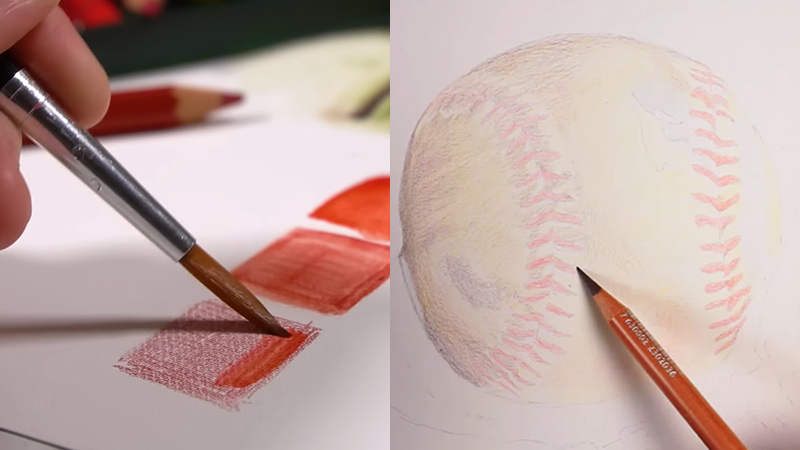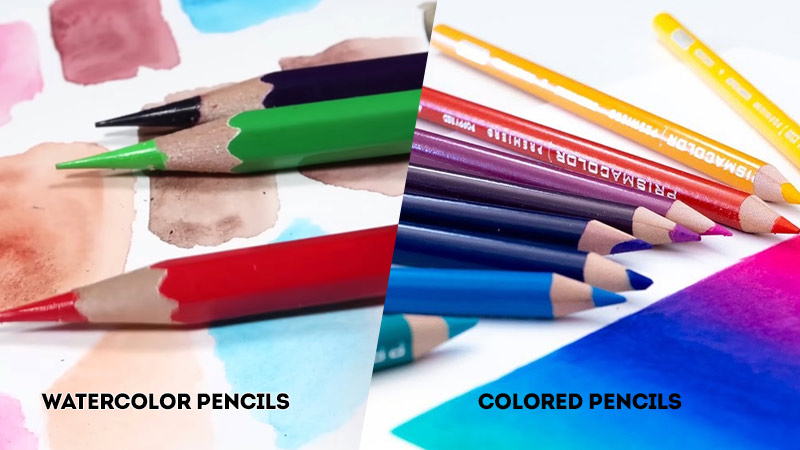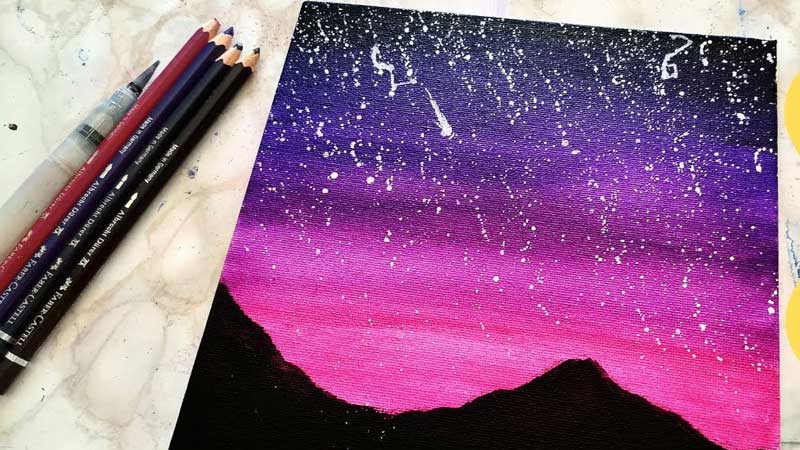When it comes to artistic tools, watercolor pencils vs. colored pencils stand as exemplars of contrast. The watercolor pencils comparison reveals a fundamental divergence in their core composition.
Watercolor pencils, with their water-soluble pigments encased in wood, beckon the transformative touch of water, while colored pencils boldly wield wax or oil-based cores mixed with pigments for dry application.
These distinctions impart distinct traits to each medium—watercolor pencils are celebrated for their fluidity, vibrant color transformations, and blending prowess with the aid of water, whereas colored pencils excel in precise detailing, rich dry colors, and immediate results on paper.
Artists navigate these waters, choosing their weapon based on intention, style, and the desired visual effects, forging unique avenues for self-expression and creativity.

What are Watercolor Pencils and Colored Pencils?
Watercolor pencils and colored pencils are versatile tools in the world of visual art, each offering distinct creative possibilities.
Watercolor pencils contain water-soluble pigments encased in wood, allowing artists to activate them with water, resulting in fluid and vibrant washes.
In contrast, colored pencils employ wax or oil-based cores, delivering rich, opaque colors for precise detailing and layering without the need for water.
These differences extend to blending capabilities, drying times, and paper choices, influencing artists’ choices based on their intentions and artistic styles.
Whether seeking the fluidity of watercolor effects or the precision of colored pencil work, these mediums enrich the artist’s palette.
9 Difference Between Watercolor Pencils and Colored Pencils
Watercolor pencils and colored pencils are both popular art mediums, each offering unique characteristics and advantages for artists. While they share some similarities, they also have distinct differences that cater to various artistic needs and preferences.
Let’s explore the key differences between watercolor pencils and colored pencils:
1. Composition
- Watercolor Pencils: Watercolor pencils are typically made with water-soluble pigments encased in a wooden barrel. These pigments can be activated with water, allowing the artist to create watercolor-like effects when the pigment dissolves.
- Colored Pencils: Colored pencils, on the other hand, contain wax or oil-based cores mixed with pigments. They do not dissolve in water and are designed for dry application.
2. Color Intensity
- Watercolor Pencils: Watercolor pencils often produce softer, more translucent colors when applied dry. However, when water is added, the colors become more vibrant and can be layered to achieve greater intensity.
- Colored Pencils: Colored pencils typically provide more intense and saturated colors when applied dry. They may require more effort to achieve a watercolor-like transparency.

3. Layering and Erasing
- Watercolor Pencils: Watercolor pencils allow for layering and adjusting colors by applying multiple washes. However, once the pigment is wet and dried, it can be challenging to erase or make significant changes without damaging the paper.
- Colored Pencils: Colored pencils are forgiving in terms of layering and erasing. Artists can easily erase or lift color from the paper and make adjustments even after several layers have been applied.
4. Blending and Mixing
- Watercolor Pencils: Watercolor pencils excel in blending and mixing colors due to their water-soluble nature. Artists can use a wet brush to blend colors seamlessly and create gradients and washes.
- Colored Pencils: While colored pencils can be blended to some extent, they are best suited for fine detail work and layering. Blending can be achieved through various techniques such as burnishing (applying pressure), layering, or using colorless blending pencils.
5. Precision and Detail
- Watercolor Pencils: Watercolor pencils are versatile but may be less precise for intricate details when used wet due to the inherent fluidity of watercolors. They shine in loose, expressive works.
- Colored Pencils: Colored pencils are excellent for fine, detailed work. The control they offer allows artists to create intricate and precise illustrations with sharp lines and defined edges.
6. Paper Selection
- Watercolor Pencils: Watercolor pencils require heavier weight, watercolor or mixed-media paper to handle the moisture without warping or tearing the paper. This paper is designed to absorb water and pigment effectively.
- Colored Pencils: Colored pencils can be used on a wider variety of paper types, including sketch paper and drawing paper, although specialized colored pencil paper is available for optimal results.
7. Drying Time
- Watercolor Pencils: Watercolor pencil artworks need time to dry, especially if multiple layers and washes are applied. This can be an advantage for blending and correcting mistakes.
- Colored Pencils: Colored pencil drawings are dry immediately, making them more convenient for artists who prefer a quicker drying process.
8. Fixatives and Preservation
- Watercolor Pencils: Watercolor pencil artworks can be sealed with fixative sprays or varnishes to protect them from smudging and moisture. This is especially important if the artwork will be displayed or handled frequently.
- Colored Pencils: Colored pencil drawings are less prone to smudging, and fixatives are often not required. However, fixatives can be used if an artist wishes to preserve the drawing for an extended period.
9. Final Finish
- Watercolor Pencils: Watercolor pencil works often have a distinct, slightly textured, and translucent finish that resembles traditional watercolor paintings.
- Colored Pencils: Colored pencil artworks have a smoother, matte finish with more pronounced details and precise lines.
Can You Use Watercolor Pencils on Canvas?

Yes, you can use watercolor pencils on canvas but you should consider a few things. Watercolor pencils are primarily designed for use on paper, especially watercolor paper or other absorbent surfaces.
Here are some important considerations to keep in mind:
Surface Preparation
Canvas is not as absorbent as watercolor paper, so it may not readily accept watercolor pencil pigment and water.
To make it more receptive, you can apply a watercolor ground or gesso to the canvas. These products create a surface that behaves more like watercolor paper.
Texture and Tooth
The texture of the canvas can affect how the watercolor pencils perform. Canvas with a rough texture may not provide the same level of detail and precision as smoother surfaces. It’s essential to consider the canvas’s tooth and how it impacts your desired artistic effect.
Blending and Layering
Watercolor pencils are known for their blending capabilities when water is applied. On canvas, the blending may not be as smooth as on watercolor paper. You may need to experiment to achieve the desired blending and layering effects.
Drying Time
Since canvas is not as absorbent as paper, the drying time of watercolor pencil pigment on canvas may be longer. Patience is crucial to avoid smudging or disturbing the artwork while it dries.
Surface Texture
Canvas texture can become part of your artwork’s texture. Depending on your artistic intentions, this can be an advantage or a limitation. Some artists appreciate the added texture for a more tactile and dimensional look.
Experimentation
If you’re considering using watercolor pencils on canvas, it’s a good idea to experiment on a small section or a practice canvas first to get a feel for how the materials interact.
Can You Use Regular Colored Pencils as Watercolor Pencils?
Regular colored pencils are not designed to be used as watercolor pencils, primarily because they lack the water-soluble properties found in watercolor pencils.
Watercolor pencils have a specific formulation that allows their pigments to dissolve and blend when water is applied, creating a watercolor-like effect.
If you attempt to use regular colored pencils with water, you won’t achieve the same results. Instead of blending and spreading smoothly like watercolor pencils, regular colored pencil pigments will resist water and may not disperse well. This can result in uneven and less vibrant color application.
To achieve watercolor-like effects, it’s best to use dedicated watercolor pencils or watercolor paints. These art supplies are specifically formulated for use with water and will yield the desired translucent and fluid look that regular colored pencils cannot replicate.
Is It Okay to Use Colored Pencils on Watercolor Paper?
Yes, it is perfectly okay to use colored pencils on watercolor paper. In fact, watercolor paper is a versatile surface that can handle a variety of media, including colored pencils, watercolors, gouache, ink, and more.
Watercolor paper is designed to be sturdy and able to withstand wet media without warping or deteriorating, making it a suitable choice for mixed media projects.
When using colored pencils on watercolor paper, keep in mind the following things:
Paper Texture
Watercolor paper comes in various textures, and your choice can significantly impact the outcome of your artwork.
- Hot-pressed (smooth) paper offers a smooth surface ideal for fine details and precise colored pencil work.
- Cold-pressed (medium texture) paper is the most common choice and strikes a balance between smoothness and texture, allowing for versatility in your artwork.
- Rough watercolor paper has a pronounced texture, which can create interesting effects when using colored pencils, particularly if you want a more textured or rustic appearance to your work.
Layering
One of the advantages of using colored pencils on watercolor paper is the ability to layer colors. Colored pencils adhere well to the paper’s surface, allowing you to build up layers gradually.
This technique is especially useful for achieving vibrant and detailed results in your artwork.
Surface Preparation
Some artists choose to prepare the watercolor paper before using colored pencils. You can lightly apply a wash of watercolor paint or a watercolor ground to the paper.
This adds an extra dimension to your artwork by introducing a colored or textured background to work on, making your colored pencil details pop.
Pencil Selection
The quality of your colored pencils matters. Artist-grade colored pencils generally contain more pigment and have a smoother texture, which can enhance the depth and richness of your artwork.
Brands like Prismacolor, Faber-Castell Polychromos, and Caran d’Ache Luminance are popular choices among artists.
Pressure and Blending
Experiment with different levels of pressure when applying colored pencils to the watercolor paper. Varying pressure can help you achieve different effects, from light shading to bold color saturation.
You can also blend colors smoothly by using blending tools like blending stumps, tortillons, or even a colorless blender pencil.
Fixatives
To preserve your colored pencil work and prevent smudging, consider using a fixative spray designed for colored pencils. This spray helps set the pigments in place and provides a protective layer.
Follow the manufacturer’s instructions carefully when applying fixatives, as proper ventilation and application techniques are essential.
Erasing
Colored pencil marks can usually be erased from watercolor paper using a standard eraser or a kneaded eraser.
Be gentle when erasing to avoid damaging the paper’s surface. If you make a mistake, you can often correct it without damaging the paper by carefully erasing or layering over it.
FAQS
Can watercolor pencils be used on surfaces other than paper?
Yes, watercolor pencils can be applied to various surfaces like wood or canvas with proper surface preparation.
Are watercolor pencils safe to use?
Yes, they are generally safe, but avoid ingesting or inhaling dust when sharpening. Basic safety precautions apply.
Can you use fixative on watercolor pencil artworks?
Fixatives may not be as effective; consider using a sealant designed for water-based media.
Can you combine watercolor and colored pencils in one artwork?
Yes, many artists combine both mediums for a wider range of effects and creative possibilities.
Is it possible to combine both watercolor and colored pencils in a single artwork?
Yes, many artists combine these two mediums in their works to achieve a broader range of effects.
To Recap
The distinction between watercolor pencils and colored pencils reveals a fascinating interplay of characteristics that cater to the diverse needs and artistic aspirations of creators.
Watercolor pencils, with their water-soluble nature, offer a dynamic world of translucent washes, gradient transitions, and the versatility of water manipulation.
They inspire a sense of fluidity and spontaneity, ideal for expressive, loose artworks. In contrast, colored pencils, with their wax or oil-based cores, grant artists impeccable control, intricate detailing, and immediate dry results.
They shine in precision and lend themselves well to finely crafted, detailed compositions. The choice between these mediums becomes an artistic statement, reflecting the artist’s intent, style, and the visual narrative they wish to convey on paper or canvas.
Ultimately, both watercolor and colored pencils enrich the vast tapestry of artistic expression, offering unique paths to creativity.
Leave a Reply